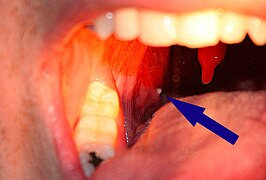If you’ve ever felt something strange in your throat and coughed up a small, white or yellowish mass with an unpleasant odor, you may have had a tonsil stone . Also known as tonsil stones , these formations can be annoying, although in most cases they don’t pose a serious health risk. However, if not treated properly, they can lead to recurring discomfort and affect oral hygiene.

Tonsil stones are small calcified deposits that form in the tonsillar crypts , natural cavities in the tonsils where food particles, dead cells, and bacteria can become trapped. Over time, these substances harden due to interaction with the calcium salts present in saliva, giving rise to these small stones. Although many people pass them without even noticing, in some cases they can cause bothersome and persistent symptoms.
The tonsils , located at the back of the throat, are part of the immune system and are responsible for trapping microorganisms to prevent infections. However, due to their multi-cavity structure, they can become the perfect environment for debris to accumulate. When these remains become trapped in the tonsil crypts and are not properly removed, they can begin to solidify and give rise to tonsil stones .
The formation of these stones is often related to a combination of factors, including poor oral hygiene , chronic tonsil infections, and individual anatomy, as some people have deeper crypts that facilitate the accumulation of debris. Furthermore, persistent bad breath is one of the most noticeable symptoms, as tonsil stones contain bacteria and decaying debris that can generate an unpleasant odor that is difficult to eliminate with brushing or mouthwash.
Other symptoms may include a sensation of a foreign object in the throat , difficulty swallowing, irritation in the area, and even recurrent tonsillitis . In some cases, people with tonsilloliths may experience episodes of persistent coughing due to the irritation they cause in the throat.
To prevent the formation of these stones, it is essential to maintain good oral hygiene . Brushing your teeth and tongue after every meal, flossing , and using antibacterial mouthwash can help reduce the buildup of debris in the mouth and prevent the appearance of tonsil stones. It is also recommended to drink plenty of water and avoid overconsumption of foods that can leave particles trapped in the tonsils.
Once tonsil stones have formed, there are several ways to remove them. In some cases, they may come out on their own when coughing or eating crunchy foods. They can also be removed with salt water irrigation or an oral irrigator. However, when the stones are larger or recurring, it is advisable to see a specialist for safe removal. Attempting to remove them manually without proper training can cause injury to the tonsils and increase the risk of infection.
In more severe cases, when tonsilloliths cause recurrent infections or significantly affect quality of life, a specialist may suggest a tonsillectomy , or the removal of the tonsils. This option is only considered when the problem is persistent and doesn’t respond to other treatments.
While tonsil stones don’t pose a serious risk in most cases, they can be a constant source of discomfort and affect oral health. Preventing their formation with good oral hygiene and seeing a professional if symptoms persist is key to avoiding long-term discomfort.



